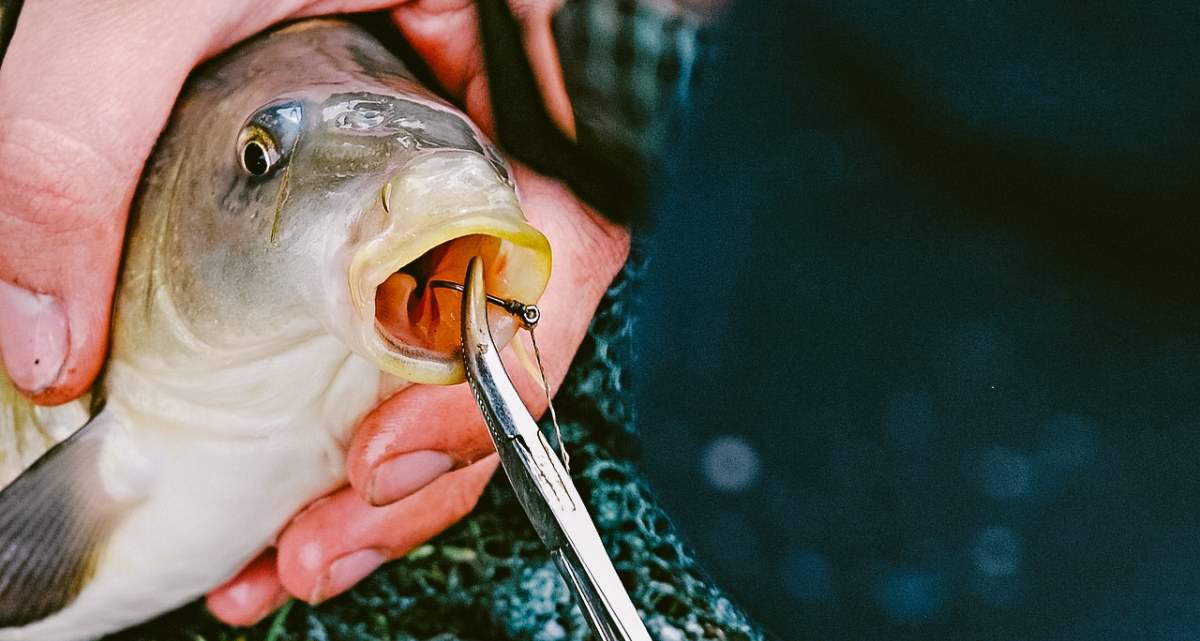When you’re in the mood for a day of fishing, there are few things more important than having the right equipment. Sure, you could go out and buy “the best” fishing rods and reels, but what about the rest of your gear? You see, even though rods, reels and lures are the most visible items in your tackle box, there’s a lot that goes into a good day of fishing — including having the right accessories.
Fishing pliers are a crucial piece of equipment for any angler. Whether you’re deep sea fishing or just out at the lake, there’s always something that requires the use of a pair of pliers. There are many different types of fishing pliers on the market and it can be difficult to make the right choice. We will review the best fishing pliers in this article for 2023.
BEST FISHING PLIERS 2023
BEST FISHING PLIERS 2023
RUNCL Fishing Pliers S1
General Impression
Anglers hunting for an impressive pair of pliers which can function as a multitool can look no further than RUNCL’s S1. This product is loaded with tons of handy features, giving it the well-deserved title of the best fishing pliers currently on the market.
The S1 is no doubt one of the best stainless-steel fishing pliers on the market, as it is crafted entirely of durable stainless-steel and then coated with Teflon. So naturally, little to no damage can ever be caused to the tool.
However, the item’s true selling point is its abundance of features. It offers holes for tightening knots, a ring splitter, a line cutter, bait adjustment slits, and crimping grooves. Many models simply don’t include bait adjustment slits or knot tightening holes, which makes the S1 a very unique model with a wide variety of uses.
Specifications
BRAND: RUNCL
INCLUDES: Pliers, sheath, lanyard
CONSTRUCTION: Stainless-steel
GRIP: Ergonomic PVC handle
CUTTING OPTIONS: Tungsten carbide cutter cuts through mono, fluoro, and braid
NOSE LENGTH: Moderately needle-nose
BEST SUITED FOR: Bass and sportfish angling
PROS
- Comfortable PVC grip
- Durable stainless-steel body
- Knot tightening holes
- Textured jaws for effective grip
CONS
- Teflon coating can scratch off
KASTKING Intimidator Fishing Pliers
General Impression
Anglers searching for a no-frills plier with great reliability can look no further than the KastKing Intimidator – a model that gets right down to business.
Unlike many of the other best pliers for fishing, the Intimidator doesn’t offer a boatload of wild features. It’s crafted with S45 steel, a Teflon coating, and a synthetic rubber handle to offer supreme control in the elements. Although it doesn’t contain many external features, the Intimidator can still do everything else that other long nose fishing pliers can do, by removing hooks, cutting line, crimping weights, and splitting rings.
Ultimately, the Intimidator is a model that goes head to head with many of the other best fly-fishing pliers, at a price point that is more than fair.
Specifications
BRAND: KastKing
INCLUDES: Pliers
CONSTRUCTION: S45 steel
GRIP: Smooth rubber handle
CUTTING OPTIONS: S45 steel can cut through line, cable, and wire
NOSE LENGTH: Lengthy needle-nose
BEST SUITED FOR: Muskie and barracuda angling
PROS
- Great for removing hooks in difficult places
- Sturdy S45 steel construction
- Split ring nose for separating rings
- Ideal for crimping small weights
- Easily cuts through all types of line
CONS
- No sheath or cover included
- Lacks a hole to tie a string to
SIDOMMA Multi-use Fishing Pliers
General Impression
Although the brand is far less well known than many competitors, Sidomma certainly makes some of the best pliers for fishing with their multi-use pliers.
The multi-use fishing pliers are crafted from anodized aluminum, which ensure that they can be taken into both salt and freshwater environments. Similar to many of the other top products, the multi-use is equipped with a blade for line cutting, grooves for crimping, and an edged tooth to open split rings.
When using the tool, anglers can comfortably grab hooks out of mouths due to the spring-loaded mechanism which keeps the nose spread at all times. The whole package comes in a neat gift box, complete with a sheath, lanyard, and of course, your set of pliers.
Specifications
BRAND: Sidomma
INCLUDES: Pliers, sheath, lanyard, gift box
CONSTRUCTION: Anodized aluminum
GRIP: Countoured rubber handle
CUTTING OPTIONS: Vanadium blades cut through mono, fluoro, and braided lines
NOSE LENGTH: Moderately compact
BEST SUITED FOR: Bass and sportfish angling
PROS
- Durable vanadium cutting blade
- Stylish gift box
- Great lock placement
- Effortlessly crimps weights
- Easily opens split rings
- 12-month warranty
CONS
- Cutting blade may need replacement in time
LIXADA Fishing Pliers
General Impression
Lixada offers an impressive tool with their premier fishing pliers, which are designed to work in both fresh and saltwater environments.
Visually, the pliers stand out from competitors with their bright metallic sheen, which comes in a variety of colors. This glaringly obvious color immediately shows that there is no rubber hand cover, however, the shape of the handle is more than adequate.
Composition wise, Lixada’s pliers are fashioned from aircraft-grade aluminum that effectively resists corrosion and saltwater wear. The most notable features found on the product are the line cutters, crimping groove, and spring-loaded handles. Unlike many traditional pliers, Lixada offers a slightly longer and more pointed needle-nose, to give anglers the chance to remove hooks in difficult to reach places.
Specifications
BRAND: Lixada
INCLUDES: Pliers, sheath, lanyard
CONSTRUCTION: Aviation-grade aluminum
GRIP: Grooved metal handle
CUTTING OPTIONS: Titanium-coated blade cuts mono, fluro, braid, and wire
NOSE LENGTH: Lengthy needle-nose
BEST SUITED FOR: Bass fishing and muskie angling
PROS
- Rust-free construction
- Wide variety of colors
- Lengthy needle-nose
- Durable aircraft-grade aluminum
CONS
- Small ring splitter
- Lack of rubber may cause slippage
PISCIFUN Aluminum Fishing Pliers
General Impression
Piscifiun’s aluminum fishing pliers are a great attempt at making a solid and affordable pair of fishing pliers.
Like any of the other best aluminum fishing pliers, Piscifun’s variant is a durable and lightweight product that is resistant towards rust and saltwater corrosion. The interior of the tool features an edge to open split ring, a tungsten blade to cut lines, and notches to crimp sleeves. All the basics are covered, but where the piece could use a slight improvement is its split ring edge. This feature is slightly larger than need be, and so could potentially interfere with unhooking fish.
Nevertheless, the spring-loaded Piscifun fishing pliers are a great bet for any angler tackling freshwater and inshore species.
Specifications
BRAND: Piscifun
INCLUDES: Pliers, sheath, lanyard
CONSTRUCTION: Anodized aluminum
GRIP: Grooved metal handle
CUTTING OPTIONS: Tungsten carbide cuts mono, fluoro, and braid
NOSE LENGTH: Moderate needle-nose
BEST SUITED FOR: Bass and sportfish angling
PROS
- Fully replaceable cutting blade
- Spring-loaded handle mechanism
- Convenient lanyard attachment
- Compression-resistant
- Anti-corrosive construction
CONS
- Odd-shaped handle
- Ring-splitter is very large
BOOMS FISHING X1 Aluminum Fishing Pliers
General Impression
Booms Fishing offers a reliable pair of pliers with their X1 series – a lineup of pliers meant for both fresh and saltwater settings.
X1 aluminum pliers are crafted with aluminum bodies and stainless-steel jaws, to provide strength and durability where needed, while remaining light and maneuverable.
Every variant is equipped with grooves for crimping, spring-loaded handles, and stainless-steel line cutters. These features should come as no surprise, as nearly all the quality models offer them. However, what Booms does get seriously right is the ring splitter, which in their case is extremely pointed and just small enough to still serve its purpose while not getting in the way of unhooking fish.
Specifications
BRAND: Booms Fishing
INCLUDES: Pliers, lanyard, sheath
CONSTRUCTION: Aluminum
GRIP: Grooved metal handle
CUTTING OPTIONS: Stainless-steel blade cuts mono, fluoro, and braid
NOSE LENGTH: Moderate needle-nose
BEST SUITED FOR: Bass and sportfish angling
PROS
- Finely crafted ring splitter
- Stainless-steel jaw
- Well-fitted sheath
- Lightweight aluminum body
- Decently long nose for removing hooks
CONS
- Slightly unnatural handle
- No handle locking mechanism
CALAMUS A7 Lightweight Aluminum Fishing Pliers
General Impression
Due to their comfortable design, quality materials, and general reliability, Calamus A7 models can clearly be labeled as some of the best fishing pliers currently on the market.
Calamus A7 models are equipped with vanadium line cutters, grooved notches for crimping, and split ring edges for quick on-the-go maintenance. The multiple features are built upon aluminum constructions, to prevent the tools from ever being able to develop rust. However, that aluminum frame is partially covered by a comfortable and ergonomic rubber handle, which is spring-loaded to keep the nose open. A lock button is located on the side to clasp the pliers together for storage and travel.
All in all, A7 models are some of the best pliers for fishing in both freshwater and saltwater environments, due to their quality design and incredible functionality.
Specifications
BRAND: Calamus
INCLUDES: Pliers, sheath, belt-clip, lanyard
CONSTRUCTION: Aluminum
GRIP: Comfortable soft rubber handle design
CUTTING OPTIONS: Vanadium line cutters can cut mono, fluoro, and braided lines
NOSE LENGTH: Moderately compact
BEST SUITED FOR: Bass and sportfish angling
PROS
- Comfortable rubber handle
- Spring-loaded construction
- Embedded crimp notches
- Split ring edge opener
- Corrosion-resistant
CONS
- Black aluminum paint can show scratches
ZACX Fishing Pliers
General Impression
ZACX pliers are a great bet for any angler looking to dig deep in the mouths of fish, cut line, or separate split rings.
The external appearance alone is impressive enough on ZACX’s pliers, as the jet-black aluminum body and stainless-steel jaw offer a brilliant shine. However, what makes the pliers such a great option are the complementary tools it comes with and the plier’s natural abilities.
Every set of pliers includes a lanyard, sheath, and fish gripper to widen the mouth of a fish while digging for hooks. The fish gripper is particularly useful as it allows the lengthy spring-loaded needle-nose pliers to dig around in a fish’s mouth with ease.
Although the true selling point is unhooking fish, the pliers still do a great job cutting lines, crimping weights, and splitting rings.
Specifications
BRAND: ZACX
INCLUDES: Pliers, sheath, lanyard, fish gripper
CONSTRUCTION: Aluminum
GRIP: Grooved metal handle
CUTTING OPTIONS: Stainless-steel blade cuts through mono, fluoro, and braid
NOSE LENGTH: Lengthy needle-nose
BEST SUITED FOR: Muskie and bass angling
PROS
- Lengthy needle-nose tip
- Handy fish gripper tool included
- Stainless-steel jaws
- Aesthetically appealing design
CONS
- Lack of rubber makes handle slippery
SAMSFX Locking Aluminum Fishing Pliers
General Impression
Few brands offer as complete of a set as SAMSFX with its locking aluminum fishing pliers’ bundle.
While many sets simply offer pliers and lanyards, SAMSFX goes above and beyond by including a sheath, lanyard, quick-knot tool, and clippers.
Construction-wise, the tool is like many other top-rated products (an aluminum body equipped with all the standard bells and whistles). There are grooves for crimping, a blade for line cutting, toothy edges for ring splitting, and a locking latch to secure the spring-loaded handle. The best of all these pliers have to offer is that each feature works exactly as expected, particularly the well-designed cover that is no doubt the best fly-fishing sheath on this list.
Specifications
BRAND: SAMSFX
INCLUDES: Pliers, sheath, lanyard, clippers, quick tie tool
CONSTRUCTION: Aluminum
GRIP: Smooth metal handle
CUTTING OPTIONS: Tungsten carbide blade cuts through mono, fluoro, and braid
NOSE LENGTH: Short needle-nose
BEST SUITED FOR: Bass and sportfish angling
PROS
- Efficiently shaped handle
- Well-designed sheath
- Fully replaceable cutting blade
- Durable aluminum frame
CONS
- Short nose length
BEST FISHING PLIERS
Buyer's Guide
Traditional Vs. Needle Nose Vs. Crimping Pliers
Traditional freshwater and fly-fishing pliers closely resemble the tools found in a workshop, as they possess short forceps and pointed nose pieces. Needle nose pliers on the other hand, more closely resemble the tools found in a medical or surgical setting, with slightly longer forceps and a longer nose coming to a sharp point. And finally, there are crimping pliers which closely resemble the tools electricians use to cut wire.
In most freshwater settings, a pair of traditional pliers with a pointed nose is adequate for general maintenance. Such models often possess various other features, such as crimping notches, line cutters, and split ring separators. In a way, traditional pliers are more of a multi-tool, which can perform a variety of tasks. All in all, they are the best fishing pliers for the money due to their multitude of functions.
Stainless-steel needle nose pliers on the other hand, are more useful when trying to remove hooks from fish with small mouths or jagged teeth. Species such as barracuda, muskies, and alligator gar all have sharp rows of teeth, making removing the hooks from their mouths a legitimate safety concern. The same applies to many other species of saltwater fish, making needle nose pliers slightly more useful for seaside anglers.
However, most manufacturers now make hybrid models, which combine needle-nose and traditional pliers into one. The majority of the items on this list fall into that category.
Finally, there are crimping pliers, which are extremely heavy-duty pliers with short noses designed specifically for crimping. Such pliers often just contain a few notches to align the sleeves in – nothing more. Like needle nose pliers, crimping pliers are a bit of a one-trick pony. Many traditional pliers can crimp smaller sized sleeves, but when it comes to large scale, crimping pliers are a must.
Material
Science has come a long way in recent years, presenting brilliant new polymers and plastics that can withstand large amounts of force and damage. Nevertheless, plastics still don’t have the same properties as metallic products, so it is difficult for them to meet the same standards.
Plastic fishing pliers can be effective at removing bait from the mouths of fish, as such a task doesn’t require too much force from the tools. For this reason, plastic pliers are a viable option when simply removing hooks.
The best aluminum fishing pliers on the other hand, are far more useful for maintenance and equipment tasks. Aluminum pliers often possess grooves for crimping sleeves, blades for cutting line, and edges for separating split rings. And as one could imagine, aluminum can endure far more force than plastic. Aluminum models make up most of the best saltwater fishing pliers of 2023, due to the material’s durability and immunity to rust.
Finally, there are stainless-steel and titanium models, which are no doubt the most heavy-duty variants. Both materials are incredibly strong and durable, making it easy to crimp sleeves and cut even wired lines. Both are fantastic choices for both saltwater and freshwater settings, as they can perform any task without incurring damage.
However, it is worth noting that stainless-steel models must be kept dry and regularly oiled to resist rust. Titanium models contain no iron, so like aluminum, they will not rust. Nevertheless, the material itself is rarely seen in pliers due to its high price point.
Spring-Loaded Vs. Traditional
In many situations, having a pair of spring-loaded pliers can be a true blessing, as a feature such as this makes removing hooks far easier.
Spring-loaded pliers are equipped with a spring mechanism in between the handles, to pry the nose of the pliers open. With such a feature, the only thing left to do is clasp down.
Traditional pliers on the other hand have no mechanism to open the nose and require handlers to both open and close the tool. While the difference is minimal, the convenience is noticeable.
Those regularly using pliers to work in a fish’s mouth are best off with a pair of spring-loaded pliers. However, a traditional pair will work just fine too, even though they do require a bit more work.
Split Ring Nose Piece
Anglers frequently dealing with crank baits, swim baits, and other hard plastic lures must often change the split rings securing the hooks to the lures. While it is somewhat of a necessity, separating the rings themselves is quite a challenge. Thankfully, many of the best fishing pliers of 2023 now come with split ring separators. These split ring separators can be found at the end of the nose, in the form of a slight jagged edge which the rings can rest on. Once a ring is placed on top of the separator, a quick squeeze can separate the piece enough to allow it to thread onto lures or other tools.
Those who frequently deal with split rings on crankbaits, spinners, and swivels are best off searching for a pair of pliers with a separator, as the feature is one that any saltwater fishing pliers review would mention as a necessity.
Complementary Items
Many fishing kits come with complementary items these days, to further entice anglers into choosing specific products. In the case of pliers, complementary items can be lip-grippers, sheaths, lanyards, clips, even fishing knives and more.
The most common complementary items to hunt for are sheaths and lanyards. Both items are fairly standard with many models and can be extremely helpful in a variety of situations.
A well-built fishing pliers sheath provides protection from the elements, shielding aluminum or stainless-steel products from water, mist, and sand. The added protection can help prevent rust and erosion, keeping the gears and internal mechanisms operating smoothly.
Lanyards, on the other hand are more of a convenience item. Attaching a lanyard to a pair of pliers makes it easy to quickly grab the pair without endlessly searching for them. Such a mechanism also prevents anglers from losing their tools overboard, as the lanyard simply catches the piece before it sinks to the bottom.
BEST FISHING PLIERS
FAQs
Why do I need fishing pliers?
Fishing pliers can be extremely handy tools that can save tons of time and frustration when on the water.
For the most part, the primary purpose of fishing pliers is to remove hooks wedged into the rough and abrasive mouths of fish. Oftentimes, it is too difficult to remove a hook stuck deep in the mouth of a fish with just one’s hands due to the amount of space, so additional tools are required. In moments like this, needle nose fishing pliers, or other traditional fishing pliers can be absolute life savers – for both the fish and the angler.
Although they are most often used to remove hooks, good fishing pliers can also be beneficial when equipping bait, separating split rings, and cutting line/wire. With a reliable pair any angler can easily cut through mono, fluoro, braided, and even wire lines.
What are fishing pliers used for?
Similar to standard pliers, fishing pliers are used to reach and work in tight spots that one’s hands simply cannot. When it comes to angling, this includes removing hooks from a fish’s mouth, cutting line/wire, crimping sleeves, and separating split rings.
However, in order to fully understand the uses, they are broken down below.
First and foremost is removing hooks from the mouths of fish, which is fairly self-explanatory. Occasionally space is limited in a fish’s mouth, or worse yet – they have big shiny teeth which makes it unsafe or impractical to use one’s hands.
Second off, is cutting line and wire. Heavy-duty fishing line such as 100+ lb. test is difficult to cut with traditional clippers, so using pliers is the most effective way to trim swathes or leader pieces.
The third purpose, which is crimping sleeves, is slightly more complex. Sleeves are hollow metal tubes which line is threaded through when it is too thick to efficiently tie. Once the line has been threaded through, any pair of the best fishing pliers for saltwater will do in crimping the line.
And the fourth and final use of pliers, is to separate split rings. The tiny rings used to equip hooks to lures are often a pain to slide onto rings, so having a tool to separate them and save an angler’s fingernails is a massive bonus.
What are the different types of fishing pliers?
For the most part, there are just two types of fishing pliers – traditional and needle nose, even though most modern pliers are now a hybrid.
Traditional fishing pliers are often built similar to workshop pliers, with a pointed head leading into a comfortable handle. In most cases, traditional fishing pliers are equipped with blades for cutting line, and notches for crimping metal sleeves. These two features make traditional pliers the most widely used due to utility in most fishing situations.
Needle nose fishing pliers on the other hand, are built with a long slender neck to give anglers the chance to reach deep into a fish’s mouth. The extended neck has two main benefits; reaching difficult places and providing anglers with safety when removing bait from a fish’s mouth that may be loaded with teeth. Unlike traditional pliers, long nose fishing pliers don’t often come with any other features.
What are the best saltwater fishing pliers?
The best saltwater fishing pliers anglers can reach for are likely the Calamus A7 pliers.
Calamus A7 pliers are crafted entirely of aluminum, making them a great option for saltwater environments that rapidly corrode steel items. Furthermore, they are equipped with all the basic necessities such as a line cutter, ring splitter, and crimp notch to give anglers plenty of versatility. These features can easily be used with comfort due to the model’s snug rubber handle. Many competitors also offer the same aspects, but usually at a level of quality far below the Calamus A7 pliers.
What are the best bass fishing pliers?
Currently, the best bass fishing pliers are the RUNCL S1 stainless-steel pliers.
The S1 model is an all-around contender, with great material composition, useful features, and respectable longevity. Every pair is crafted entirely out of stainless-steel and coated with a comfortable PVC handle.
Feature wise, RUNCL’s premier pliers offer a line cutting blade, ring splitter, crimp notch, knot tightener, and bait adjuster. The wide variety of features makes it easy for anglers to remove bait from the mouths of fish, while also maintaining their line and fishing gear.
How do I use split ring fishing pliers?
Split rings can be an absolute nightmare to equip, so having a pair of pliers to help can be a huge time and fingernail saver.
To use split ring pliers, an angler simply needs to align the ring directly on the end of the plier where the pointed edge is. Once the ring is placed directly on top of the edge, one can just clasp down to unwind the split ring and thread it onto a hook or lure.
Why do I need aluminum or stainless-steel pliers?
Aluminum pliers and stainless-steel fishing pliers are far more effective than hardened plastics or casts, due to their material composition.
Molded pliers made from synthetic plastics are often too weak to clasp down on sleeves and effectively crimp them. The plastic itself simply gives way and bends alongside the metal. While they are handy in the case of removing hooks, they simply don’t have enough fortitude to perform other necessary tasks.
So, this is where aluminum and stainless-steel pliers come in as they can not only crimp sleeves, but also cut line and unwind split rings. Though they do require a bit more maintenance, they are certainly a better bet than plastic competitors. Of course, there are a few pairs of titanium fishing pliers floating around on the market, but their price point is simply not worth their functionality, as any high-quality pair of stainless steel can perform just as well.
How to use crimping pliers for fishing?
Tying knots in heavy-duty fishing line is like tying telephone wires together – its no simple task. So, in order to still attach hooks and tackle to such thick lines, it is often necessary to crimp the line with crimping sleeves.
Crimping sleeves are hollow metal cuts, crafted from either one or two empty barrels. In the case of double barrel sleeves, the fishing line slides in one side of the barrel to feed through a hook, then back up through the other side. Once the line is nearly flush with the other side of the barrel, a solid pair of stainless-steel fishing pliers can be used to crimp the line pieces together.
To crimp the sleeve together, anglers simply have to fit the piece into the properly sized notch of the pliers and compress the pliers until they return to their closed position. Note, it is important to choose the proper notch, ensuring it is not too small as a smaller size often cuts into the line and ruins it entirely. Once the right size is chosen, anglers can crimp the sleeve as many times as needed, depending on the length of the barrel. However, it is key to avoid crimping the end when using monofilament, as burning the end of mono line creates a bulbous effect that is a useful last line of anti-slippage. When it comes to wire, crimping the end of the pieces together is recommended as it digs into the material providing a more secure connection.
How do I remove a hook using fishing pliers?
Removing hooks with pliers is significantly easier than removing hooks by hand. So of course, many anglers reach for the pliers when a hook is thoroughly stuck in the mouth of a fish.
To remove a hook with pliers, an angler simply needs to grab the hook with the nose of the pliers and create a twisting action back towards the entry point. Rotating the pliers back is often enough to pop a hook right out of a fish’s mouth.
However, some circumstances aren’t so easy, requiring an angler to get creative, even if they are wielding some of the best fishing pliers available. In cases where a hook won’t back out of a fish’s mouth, it is best to pull the hook all the way through the mouth, until the point has broken skin and reappeared. Once this is done, an angler can simply clamp the barb off the hook or cut the tip off with pliers. The hook can then be backed out with the rotation method mentioned above.
What would I need spring-loaded fishing pliers for?
Spring-loaded fishing pliers aren’t an absolute necessity, but they definitely make handling the tools far easier.
Spring-loaded mechanisms pry the handles apart, to create a wide-open nose that simply needs to be clamped down. This aspect makes such models incredibly useful when searching for a hook in a fish’s mouth. Constantly having to open and close traditional pliers makes the whole process a hassle, so having a spring-loaded mechanism to consistently keep pliers open just simplifies things that much more. Such a feature isn’t a total necessity but having a pair of the best fishing pliers with a spring mechanism certainly is a helpful bonus.
How do I take care of my saltwater fishing pliers?
No saltwater fishing pliers review would be complete without mentioning how to care for the tools. Unlike freshwater, saltwater is extremely corrosive, and has the potential to rust away at pliers and fishing reels not properly cared for.
To ensure the quality of saltwater pliers, anglers must rinse them with fresh water immediately after a seaside trip. Once done, the best practice is to dry the tools entirely, by cloth or towel. After all the moisture has been wicked away, lubricating substances such as oil, grease, or anti-rust spray can be applied to further enhance the lifetime of the tools.
Those who frequently visit the seaside are best off searching for saltwater fishing pliers with a sheath, as the extra layer of protection helps maintain the quality of the pliers exposed to the elements. Like quality sunscreen on humans, a quality sheath can greatly increase a tools life.
Reach Out
As always, we create our content with you, fellow adventurers, in mind. So, how’d we do? Did you find this informative? Did it help you make a decision? Did we miss anything? We’d love to hear from you below. Thanks for reading and we hope your next adventure is a great one!



































